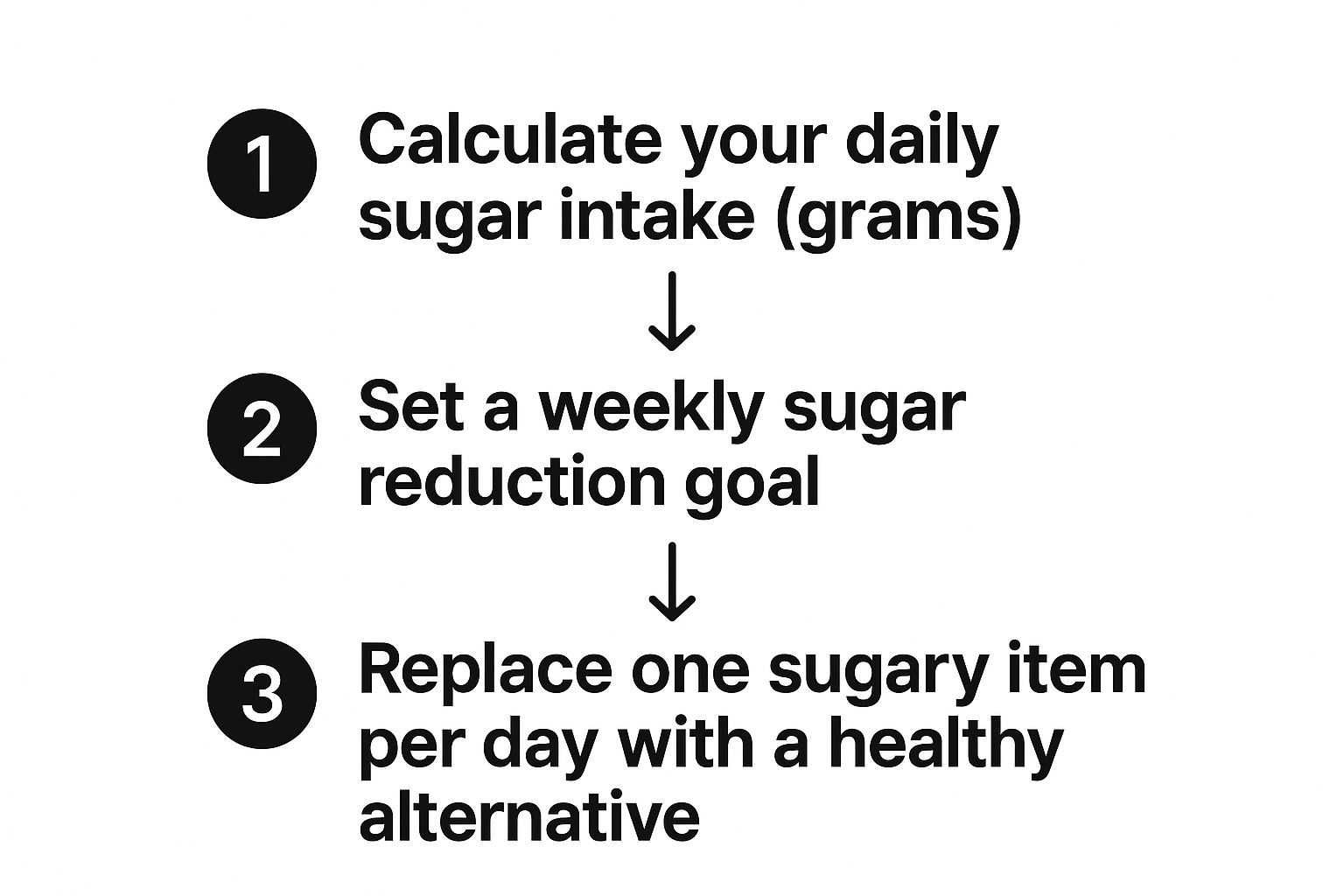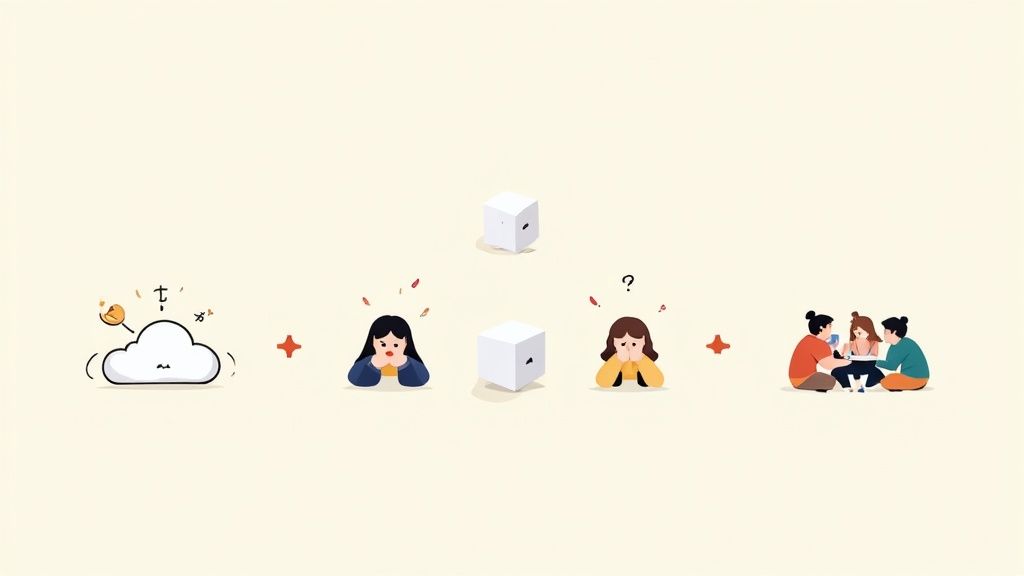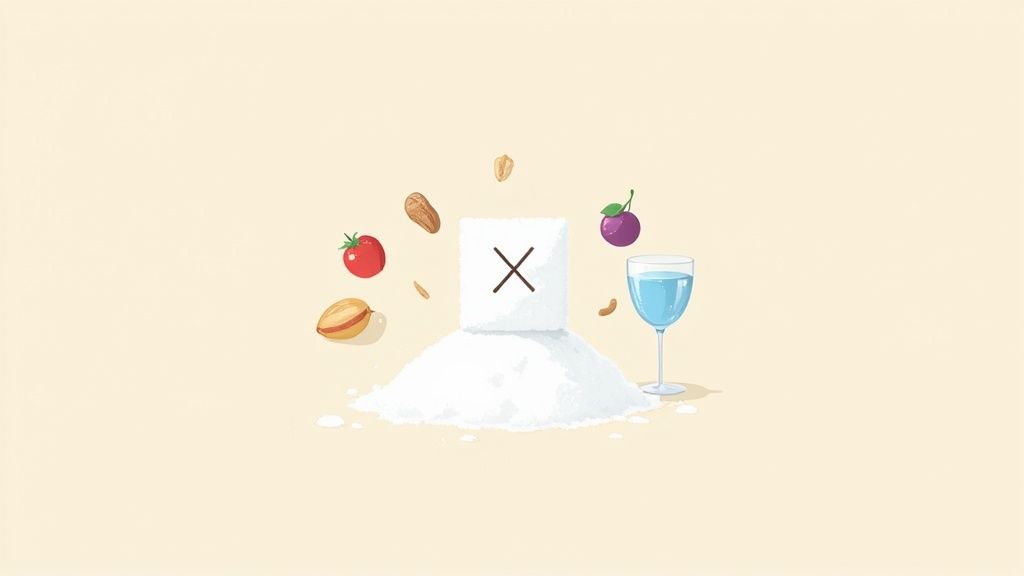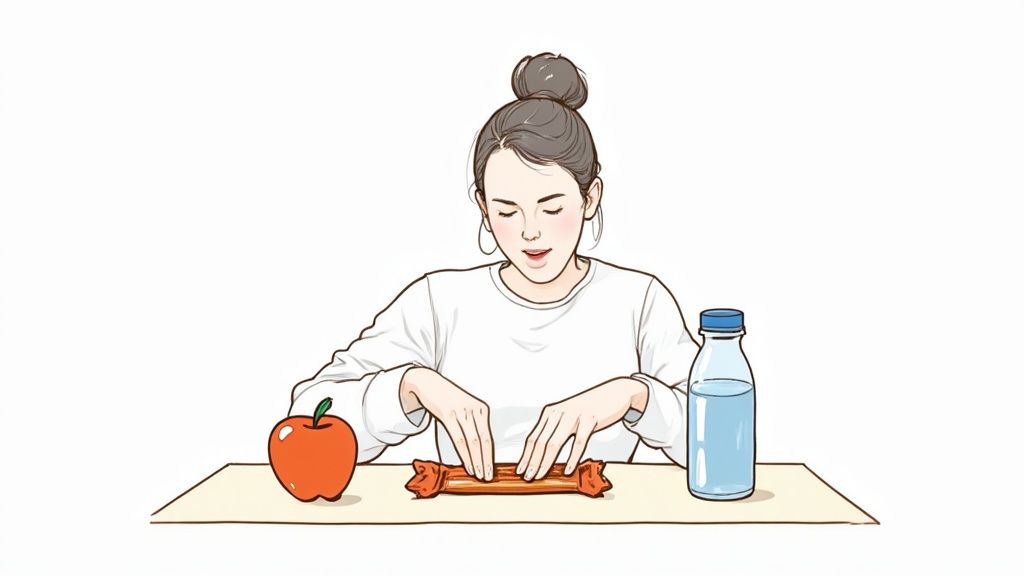How to Stop Eating Sugar: Easy Tips to Feel Better Fast

Breaking up with sugar isn't about going cold turkey. That all-or-nothing mindset is what trips most people up. The real secret? Making small, consistent changes that you can actually stick with. Think about swapping just one sugary drink for water each day or becoming a master at reading food labels to spot those sneaky hidden sugars.
It's about taking the mystery out of the process and setting yourself up for a win from day one.
So, Why Is Quitting Sugar So Darn Hard?
Let’s get one thing straight: if you've tried to quit sugar and felt like you were fighting a losing battle against cravings, you’re not alone. This isn't a simple lack of willpower. There’s some serious brain chemistry at play.
Sugar lights up the reward centers in your brain by releasing dopamine—that "feel-good" chemical. Your brain loves that feeling and quickly learns to crave the source. This creates a powerful psychological loop that can be incredibly tough to break.
The problem gets bigger when you realize just how much sugar surrounds us. It’s not just in the obvious stuff like cake and soda. It’s hiding in plain sight in foods you’d never expect to be sweet:
- Jarred pasta sauces
- Store-bought salad dressings
- Many types of bread and crackers
- Flavored yogurts and most breakfast cereals
This constant, often unintentional, exposure keeps that craving cycle spinning. And it's not getting any easier. Global sugar production is expected to reach a staggering 188.8 million tonnes, making it cheaper and more accessible than ever.
Your First Move: A Simple, Actionable Plan
Instead of trying to be perfect overnight, just focus on making one small, smart change at a time. It’s a much more manageable—and successful—way to start.

This approach is all about awareness and strategic replacement, not deprivation. When you start by tracking your intake, you get a clear picture of where your sugar is really coming from. That knowledge makes it so much easier to pinpoint exactly what to swap out first.
To get started, here’s a simple plan for your first week. The goal isn't zero sugar; it's just less sugar.
Your First Week Sugar Reduction Plan
| Day | Focus Area | Actionable Swap Example |
|---|---|---|
| 1 | Sugary Drinks | Replace one soda or sweetened coffee with a glass of water or unsweetened tea. |
| 2 | Breakfast | Swap a sugary cereal for plain oatmeal with fresh berries. |
| 3 | Condiments | Check the labels on your sauces. Try a no-sugar-added ketchup or mustard. |
| 4 | Snacks | Trade your usual candy bar for a handful of almonds or an apple. |
| 5 | Dessert | Instead of ice cream, have a small bowl of Greek yogurt with a drizzle of honey. |
| 6 | Salad Dressings | Ditch the bottled dressing for a simple mix of olive oil and vinegar. |
| 7 | Review & Repeat | Look back at your week. What was easy? Pick one swap to make a permanent habit. |
This table is just a guide to show you how small the changes can be. You're building momentum, not running a marathon.
The key is to demystify how to stop eating sugar. Show yourself that consistent, small changes are far more powerful than a drastic overhaul you can't maintain. Success is built one smart swap at a time.
As you start cutting back, your body will need time to adjust. It's completely normal to face some challenges in the beginning. To stay ahead of the game, it helps to know what to expect. You can learn more about the common sugar withdrawal symptoms and get tips on how to manage them. Being prepared is the best way to power through those crucial first few weeks.
Setting Up Your Environment for Success

Let's be honest, trying to quit sugar with willpower alone is a losing battle. The real secret? It has so much more to do with your surroundings than you think. If temptation isn't staring you in the face, it's a whole lot easier to stay on track.
That's why the most powerful first move you can make is to "sugar-proof" your home with a full pantry audit.
This isn't about guilt or tossing everything in the bin. It's about opening your eyes. Go through your kitchen—the cupboards, the fridge, even the freezer—and start reading labels. You'll probably be shocked at the hidden sugar in things you thought were healthy, like pasta sauce, salad dressings, and even your favorite bread.
Key Takeaway: The point isn't to have an empty kitchen; it's to have a kitchen stocked with choices that actually support your goals. Making the healthy choice the easy choice is the key to making this stick.
Once you’ve identified the high-sugar culprits, you’ve got a couple of options. You can get rid of them completely, or, if you live with others, just move them to a spot where you won’t see them every day. Simply making it harder to mindlessly grab that sugary snack can make all the difference.
Restock with Smart Swaps
An empty pantry is a fast track to ordering takeout. The next, crucial step is to restock with delicious, satisfying alternatives so you're never caught hungry and unprepared. Think of it as an upgrade, not a restriction.
The goal here is to have go-to foods ready for every meal and snack. Here are a few ideas that have worked for countless people:
- Sweet Cravings: Keep fresh fruit like berries, apples, and pears handy. A bowl of full-fat plain Greek yogurt with a dash of cinnamon can also hit the spot surprisingly well.
- Savory Snacks: Ditch the sugary crackers for whole-grain versions, seed crackers, or sliced veggies with hummus. A handful of nuts or seeds is another great way to crush hunger.
- Cooking Staples: Look for pasta sauces and condiments with no sugar added. For dressings, you can’t beat a simple mix of good olive oil and vinegar instead of bottled versions that are often packed with sweeteners.
Being prepared like this means that when a craving inevitably hits, a healthy, low-sugar option is the most convenient thing you can reach for.
Navigating Social Situations
Of course, your environment isn't just your home. Office potlucks, dinners out with friends, and family holidays can feel like navigating a minefield when you're avoiding sugar. Success in these situations is all about planning ahead.
Heading to a party? Offer to bring a healthy, low-sugar dish you know you'll enjoy. That way, you’re guaranteed to have at least one safe option on the table. When you're eating out, scope out the menu online beforehand to find healthier meals. And don't ever be afraid to ask for dressings or sauces on the side—it's a common request!
You don't need to make a big deal out of it, either. A simple, "No thanks, I'm cutting back on sugar," or "I'm going to pass on dessert tonight, but thank you!" is usually all it takes. Most people will respect your choice without a second thought. By preparing your environment and your responses, you're setting yourself up for success, no matter where you are.
How to Spot and Replace Hidden Sugars

Let's be honest. When you decide to stop eating sugar, one of the biggest challenges isn't just about willpower—it's about what’s hiding in plain sight at the grocery store. Sugar is a master of disguise, lurking in countless processed foods you'd never think of as sweet. This is where the real work begins. It’s not about fighting cravings 24/7, but about outsmarting the food industry.
Think about your usual shopping list. Jarred pasta sauce, sliced bread, even that "healthy" yogurt you love? Many are packed with added sweeteners to make them taste better and last longer on the shelf. This constant, low-level exposure to sugar keeps you stuck in a cycle of wanting more, which can make a clean break feel almost impossible.
Become a Label Detective
Your best weapon in this fight is learning to read and understand a nutrition label. It’s a skill. Food companies know people are getting wary of the word "sugar," so they've come up with over 60 different names for it to keep you guessing.
Learning to spot these aliases is a total game-changer. A good rule of thumb is to be suspicious of any word ending in "-ose" or any term that sounds a bit too natural to be true.
- The usual suspects: Dextrose, fructose, maltose, sucrose.
- Syrups and nectars: High-fructose corn syrup, rice syrup, agave nectar, maple syrup.
- Other sneaky names: Barley malt, molasses, fruit juice concentrate, cane juice crystals.
Always check the ingredients list. It's organized by weight, so if you see one of these names in the top three ingredients, you can bet that product is high in sugar.
A savvy consumer is an empowered one. The moment you start recognizing these hidden sugars, you take back control from food companies and put it squarely in your own hands.
This awareness is more important than ever. Worldwide sugar consumption is projected to climb to an estimated 202 million tonnes by 2034, mostly because it's being added to more and more processed foods.
Surprising Sugar Traps and Simple Swaps
Alright, now that you know what to look for, let's talk about some of the most common culprits lurking in your kitchen. Once you see where the sugar is hiding, making simple, effective replacements becomes second nature.
Here are a few common foods that are surprisingly high in sugar, along with some easy alternatives.
Salad Dressings
This one gets a lot of people. Many bottled dressings, especially the "light" or "fat-free" ones, use a ton of sugar to make up for the lack of fat. A typical two-tablespoon serving can have as much sugar as a small cookie.
- The Swap: Make your own! A simple vinaigrette with olive oil, vinegar, salt, and pepper takes less than two minutes to whip up. If you're buying it, look for brands that proudly state "0g added sugar" on the label.
Savory Sauces
From pasta sauce to ketchup and BBQ sauce, condiments are notorious sugar traps. Just a single serving of some popular BBQ sauce brands can contain over 12 grams of sugar.
- The Swap: Look for brands with no sugar added. For pasta sauce, a can of crushed tomatoes with your own herbs is a fantastic—and cheap—alternative.
Flavored Yogurts
That little container of fruit-on-the-bottom yogurt? It can easily pack over 20 grams of sugar, turning what you thought was a healthy snack into a full-blown dessert.
- The Swap: Go for plain, unsweetened Greek yogurt. You can add your own fresh berries, a dash of vanilla, or a sprinkle of cinnamon for flavor. This switch alone will slash your daily sugar intake and is a huge step in learning how to quit sugar cravings for good.
Building Sustainable Low-Sugar Habits

If you really want to cut back on sugar for good, you can't think of it as a diet. Diets are temporary. This is about building a new foundation of habits—a lifestyle that sticks. The secret isn't just about what you're taking away; it’s about what you're adding in to create a more satisfying way of eating.
The biggest piece of this puzzle is mastering your meals. When your body is properly fueled, those intense, nagging sugar cravings naturally start to disappear. The whole idea is to build meals that keep you full and your blood sugar stable, so you can sidestep the energy crashes that usually send you searching for a quick sugar fix.
Fuel Your Body to Fight Cravings
Your plate is your first line of defense. Seriously. Every meal should be a smart mix of protein, fiber, and healthy fats. This powerhouse trio works together to slow down digestion and the release of sugar into your bloodstream, which is the key to breaking that awful spike-and-crash cycle.
- Protein Power: Make sure you have a solid source of lean protein like chicken, fish, beans, or tofu at every meal. Protein is a game-changer for satiety—it makes you feel fuller, longer.
- Fill Up on Fiber: Load your plate with high-fiber foods. Think vegetables, fruits, and whole grains. Fiber adds bulk to your meals and helps keep blood sugar on an even keel.
- Healthy Fats for Fullness: Don't forget sources like avocado, nuts, seeds, and olive oil. Healthy fats are crucial for hormone balance and give you that lasting feeling of satisfaction after you eat.
A meal built like this—say, grilled salmon with roasted broccoli and a scoop of quinoa—gives you steady, reliable energy. It makes it so much easier to walk past the office candy jar because, honestly, you won't even be thinking about it. For more on getting started, check out our guide on how to start a sugar-free diet.
Key Takeaway: You can't outrun a bad diet, but you can definitely out-eat your cravings. Prioritizing balanced, nutrient-rich meals is the single most effective strategy to stop eating sugar for good. It's non-negotiable.
Master the Lifestyle Factors
What you eat is huge, but it's only one part of the story. A few other lifestyle factors play a massive role in your cravings and your willpower.
Hydration is Not Optional: It’s amazing how often we mistake thirst for hunger—or a sugar craving. Before you grab a snack, try drinking a big glass of water and waiting 15 minutes. You might be surprised to find that’s all you really needed.
Get Serious About Sleep: When you're running on empty, your body’s hormones get all out of whack. You produce more ghrelin (the "I'm hungry" hormone) and less leptin (the "I'm full" hormone). This hormonal mess is a perfect storm for powerful sugar cravings. Aiming for 7-9 hours of quality sleep isn't a luxury; it's essential for keeping your appetite under control.
Keep Stress in Check: Stress unleashes cortisol, a hormone that ramps up your appetite and makes you crave sugary, fatty "comfort" foods. Finding healthy outlets for stress—like a quick walk, a few minutes of meditation, or even using the Panic Button feature in the StopSugar app—can stop emotional eating in its tracks. Building these habits is how you finally win the long game against sugar.
You Don't Have to Do This Alone
Let's be honest: trying to quit sugar all by yourself is tough. It can feel like you're on a lonely island battling constant cravings. The good news? You don’t have to go it alone. By tapping into the right tools and support systems, you can build a powerful defense against sugar that actually lasts.
Technology gives us a huge advantage here. Think about it—health-tracking apps can take the guesswork out of the equation, turning a big, scary goal into small, manageable daily wins. They’re like a personal coach in your pocket, keeping you on track when no one else is around.
This is exactly what the StopSugar app was built for. It helps you keep a running tally of your sugar-free days and even lets you log your mood. Over time, you’ll get a clear picture of how ditching sugar is improving how you feel. And for those moments when a monster craving rears its ugly head, the Panic Button is a lifesaver, offering instant strategies to ride out the urge.
Find Your People
Beyond tracking your progress, there’s incredible power in connecting with others. Just knowing you’re not the only one wrestling with a late-night cookie craving makes the whole thing feel so much more manageable.
Plenty of apps and online forums are dedicated to this. They're places where you can:
- Celebrate your wins (even the small ones!) and vent about your struggles with people who really get it.
- Swap practical tips, recipes, and ideas with others who are in the trenches with you.
- Get a much-needed boost of encouragement on the days you feel like giving up.
This shared experience is more than just nice—it’s a powerful motivator that can keep you going when things get hard.
Finding your tribe, whether it’s online or in your local community, turns a personal battle into a shared mission. Honestly, having support from people who know what you’re going through is one of the best tools in your arsenal.
A New Wave of Medical Support
On top of smart habits and digital tools, medical science is also bringing new options to the table. For people who grapple with truly intense cravings and find appetite control to be a constant struggle, emerging treatments are opening up new possibilities.
You may have heard of a new class of medications called GLP-1 receptor agonists, which include drugs like Ozempic and Zepbound. While they were first created to manage diabetes, they’ve also been found to significantly quiet appetite and the constant mental chatter about food—that "food noise" that can derail even the best intentions.
This trend is already making waves. Some analysts even predict a decline in sugar consumption in developed countries starting from 2024, partly because of these medications. It points to a new, medically-assisted path for tackling high sugar intake on a broader scale, a shift you can read more about in these recent analyst insights on global sugar consumption.
Of course, these drugs aren't a simple fix or a shortcut. They're a serious medical treatment that requires a prescription and a doctor's supervision as part of a bigger health plan. But they do show how the toolkit for living a low-sugar life is expanding, giving us more ways than ever to find support—from our habits, our phones, and even our doctors.
Frequently Asked Questions About Quitting Sugar
https://www.youtube.com/embed/pXNMxkDym8I
As you start to rethink your relationship with sugar, it's only natural for questions to pop up. This is a big lifestyle shift, after all, and it's smart to wonder about the road ahead. Getting clear, honest answers can be the very thing that keeps you going when things get tough.
Let's dive into some of the most common questions people have when they decide to cut ties with sugar.
How Long Until the Cravings Stop?
This is the big one, isn't it? The honest answer is that it's a bit different for everyone. That said, most people feel a major shift after about 2-4 weeks of sticking with it. The first few days are almost always the hardest as your body and brain chemistry get used to a new way of operating.
A few things can influence your personal timeline:
- Your starting point: If your diet was very high in sugar, the adjustment period might feel a bit longer.
- Your overall diet: Fueling yourself with balanced meals full of protein and fiber is a game-changer. It helps stabilize your blood sugar, which can seriously shorten the craving phase.
- Life factors: High stress and not enough sleep can make cravings feel a lot stronger, so focusing on self-care really helps.
What Can I Eat for a Sweet Snack?
Don't worry, you have so many delicious options that aren't packed with added sugar! The real trick is to start thinking differently about what a "treat" is. Nature provides plenty of sweetness.
For instance, instead of a cookie, you could try:
- A handful of fresh berries or a crisp apple with a scoop of almond butter.
- A small bowl of plain, full-fat Greek yogurt with a sprinkle of cinnamon.
- A few squares of high-quality dark chocolate (look for 70% cocoa or higher) for a rich, sophisticated flavor.
The beauty of these snacks is they offer natural sweetness alongside fiber and healthy fats. This combination keeps you full and satisfied, preventing the blood sugar rollercoaster that just leads to more cravings.
Quitting sugar isn't about deprivation; it's about upgrading your choices. Once you realize how satisfying and tasty whole-food alternatives are, you'll genuinely stop missing the processed stuff.
Will I Lose Weight if I Stop Eating Sugar?
While there are no guarantees, a lot of people do find they lose weight when they cut back on sugar. This usually happens for a couple of straightforward reasons.
Sugary foods and drinks are often packed with "empty" calories—they give you a quick burst of energy but almost no real nutrition. When you start swapping them for nutrient-dense foods like vegetables, lean protein, and healthy fats, you naturally take in fewer calories without even trying. Over time, this simple switch can lead to weight loss and often helps reduce bloating, so you might feel leaner right away.
Should I Quit Cold Turkey or Gradually?
This is a crucial question. For most people, a gradual approach is far more sustainable and leads to better long-term success. Going "cold turkey" can be a real shock to your system, triggering intense withdrawal-like symptoms like headaches, exhaustion, and serious crankiness. It can be so unpleasant that many people just give up.
A much smoother path is to cut back slowly. Maybe start by ditching sugary sodas for a week. The following week, you could tackle sweetened breakfast cereals. This method gives your body, your taste buds, and your daily habits time to adjust, making the change feel less like a battle and more like a positive, lasting evolution.